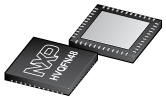Design Files
Receive the full breakdown. See the product footprint and more in the eCad file.
The NCK2983 device is a radio frequency transceiver with embedded microcontroller intended for use in an Automotive environment. All functions including customer programmable non-volatile program memory are included in a single package. The device is suitable for use in both Car Keyfob and Body Control Module type applications.
NCK2983 includes an embedded microcontroller to allow complete subsystem functions to be implemented. All device functions, including some customer programmable non-volatile memory are included in a single CMOS die.
NCK2983 is able to simultaneously receive three separate channels, where the maximum separation between the two outer band edges of the selected channels does not exceed 1.8 MHz.
The Transmitter has a high dynamic range ( -25 dBm to +12 dBm ), and efficient power ramping power amplifier. The Phase Noise of the transmitter conforms to the ARIB standard.
The transceiver is configured to operate with low active and standby power, ideal for battery powered applications. The polling mode, controlled by the internal microcontroller, may be configured by the user.
Multichannel Polling
The leading edge Wideband Digital IF approach pioneered with this device allows for multiple channels to be received in parallel. Similar in concept to a Software Defined Radio, the high performance, low noise Front-End presents the down-mixed RF signal to a high speed Sigma-Delta ADC. Once in the digital domain, this over-sampled 1.8 MHz Bandwidth IF signal (2 x 800 kHz with a 200 kHz notch in the middle) serves as input to up to three discrete Channel Digital Signal Processing units. Each Channel DSP can be configured independently, mixing down to baseband according to the specific channel centre frequency, applying relevant channel filter, demodulation and clock recovery settings for each specific channel. This parallelization of reception activities can result in a dramatic reduction of receiver 'on' time, thereby keeping the average current consumption low.
Image Rejection
Minimum Image Rejection of 50 dB is guaranteed over temperature and supply. Using an NXP onboard generated pilot tone calibration technique, combined with the onboard temperature sensor, calibration values are stored in a look-up table, ensuring optimum settling time.
RF Front End
Advanced Gain Control is made possible through the use of Attenuators. The gain of the 'active' elements within the receive path, i.e. LNA, Mixer, etc. remains fixed, the control of the gain is achieved by switching attenuators before and after the LNA, the gain switch is then immediate and predictable, requiring no settling time. The attenuation factor of these attenuators can be compensated in the digital domain, meaning that gain control can be implemented throughout data reception without the loss of any data bits. Such a strategy ensures system robustness in the case of multi-path fading, or Narrow-Band Jammers. Link Budget and System Robustness are essential parameters for modern Automotive RF systems. The NCK2983 is benchmark in all respects: Noise Figure 5 dB: FSK Sensitivity -123 dBm: In Band Jammer Rejection >60 dB.
Antenna Diversity
Two RF inputs are available for the Receiver allowing sequential antenna diversity to be performed, should one antenna show a better performance in a given environment or for a specific radio channel.

|
|
|
|
|
|
|
|---|---|---|---|---|---|
|
|
|
|
|
|
|
|
|
|
|
|
|
|
|
|
|
|
|
|
|
|
|
|
|
|
|
|
|
|
|
|
|
|
|
|
|
|
|
|
|
|
|
|
|
|
|
|
|
|
|
|
|
|
|
|
|
|
|
|
|
|
|
|
|
|
|
|
|
|
Quick reference to our documentation types.
1 documents
Please wait while your secure files are loading.
Receive the full breakdown. See the product footprint and more in the eCad file.

Receive the full breakdown. See the product footprint and more in the eCad file.
2 engineering services


There are no results for this selection.
To find additional partner offerings that support this product, visit our Partner Marketplace.